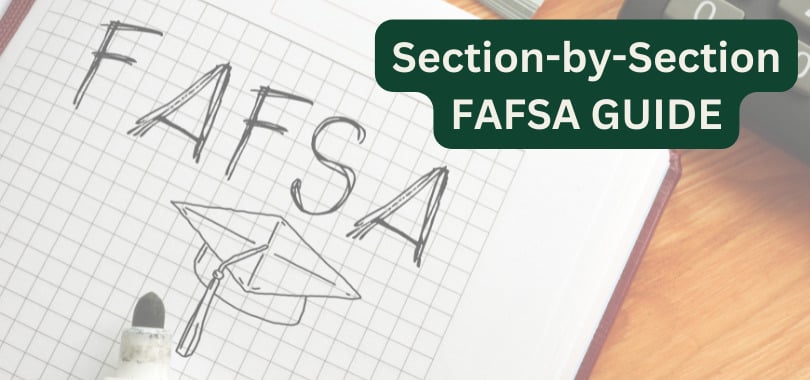The Free Application for Federal Student Aid—or FAFSA—is a form that determines a student’s financial need level, and opens the opportunity for scholarships, grants, work-study programs, and student loans. Though not strictly mandatory, the FAFSA is still a MUST for students in terms of paying for college. And, you need to know how to answer FAFSA questions fully and accurately.
Whether your goal is to pay for college, avoid crushing student loan debt, or both, the FAFSA should be your very first step. Many students avoid filing the FAFSA because they (often wrongly) believe they won’t qualify for any federal aid. Others simply aren’t aware of the benefits the FAFSA can provide.
If there’s one piece of college financial advice you should listen to, it’s this:
Always File the FAFSA
You don’t want to miss out on free aid that can help ease any financial burdens. Additionally, many outside scholarships, including grants from the colleges themselves, require the student to have filed the FAFSA, so the form counts for so much more than just federal aid. The full version of the FAFSA mobile app is available, too, making the application process at its most efficient and accessible.
And even if you didn’t receive any grants or financial aid after filling out your FAFSA the first year, don’t ignore it the years following. Schools may get additional funding for financial aid, eligibility requirements can be adjusted from year-to-year, or your income status may have changed.
Getting Started with the FAFSA
With all that said, the FAFSA can be a bit intimidating for first-time filers. So, we at College Raptor have created this helpful section-by-section FAFSA guide. We’ll take you through every question on the form, explain what it’s asking for, why it’s important to answer, how to answer FAFSA questions, and some tips you can use during your filing.
Thankfully, the Department of Education made the 2023-2024 FAFSA considerably easier to fill out than in prior years with fewer questions and a more streamlined application process.
Before you start filling out the FAFSA, it’s helpful to have a few things on hand! That includes
- Your Social Security number
- Your parents’ Social Security numbers if you are a dependent
- Your driver’s license if you have one
- If you’re not a U.S. citizen, your Alien Registration number
- Tax documents including W-2 forms
- Information about untaxed income
- Bank details including savings, investments, and real estate
You will also have to create an account before starting your FAFSA. You will need to create a username and password for your FSA ID. This account will allow you to submit your application, make changes, and view the status of your FAFSA. Students and parents can also find resources on frequently asked questions.

Section-by-Section Guide to the FAFSA
There are seven sections to the FAFSA. We will cover each of these, plus give you information on what every section asks. Depending on your answers and financial situation, some sections may automatically be skipped for you by the application program. You may not have to answer all of these questions.
Section 1: Student Demographics
FAFSA section 1 asks for:
- Name exactly as it appears on your Social Security Card
- Date of birth
- Phone number
- Address
- Length of residency in the state
- Social security number
- Citizenship status and Alien Registration number if they are not a citizen of the United States
- Education history and college grade level
- Driver’s license
- The student’s marital status
- The parents’ education levels (middle school, high school, college, or other)
Section 2: School Selection
Next, the student will have to enter their high school information, including the address, as well as the codes of colleges they’re applying to or currently attending and whether or not they will be living on campus
Section 3: Dependency Status
Section 3 has various questions on
- Marital status
- Education level
- Living situation, including foster care
- Military history
At the end of this section, students will see if they are a “dependent” on their parents or if they can continue filling out the application without their parents. If the individual is a dependent, sections 4 and 5 need to be completed.
There are special circumstances, however, for some students who are considered dependents but cannot submit their parents’ information for some reason. If this is your situation, you can select “I am unable to provide information about my parent(s)” at this time to get more details about eligibility.
Section 4: Parent Information
Section 4 of the FAFSA will be filled out by most recent high school graduates. It asks for information about the parents’ identifying information and income taxes. Boxes that need to be filled out request details on:
- Marital status of parents and date of marriage or remarriage
- Adoption status
- Parents’ identifying information (including social Security number, date of birth, name, and email address)
- Parents legal residence
- Other family members and dependents (and how many household members will be attending college in the next year)
Section 5: Parent Financials
The next section requests information about the parents’ financial situation. The FAFSA will request information on tax returns, but if the parent decides to use the IRS Data Retrieval Tool (DRT), the tax information will automatically be input into the application!
For those who are unable to use or decide not to use the IRS DRT, questions will focus on
- Income and income tax
- Employment status
- Educator expenses
- Untaxed income
- Assets (including cash, savings, and real estate)
- Other financial details (including financial aid, education credits, IRA distributions, child support, and more.)
In some cases, the Department of Education may ask for further information on assets or income after the FAFSA has been submitted.
Section 6: Student Financials
Students, like their parents, are also welcome to use the IRS DRT to input their tax and income information. If the individual cannot use the DRT, though, they will have to supply similar information to the questions listed above in section 5 if applicable.
Section 7: Sign & Submit
The final section is signing and submitting your FAFSA! You will have to review your information and ensure everything is correct. While you can make corrections after you submit your application, it is better to have all your ducks in a row the first time. You can always save and come back to your application if you’re not sure about some details! Mistakes or falsifying information on the FAFSA can land you in serious hot water.
Students will also have to answer a few other questions in this section. But these do not determine eligibility. Questions include:
- What is your gender?
- Are you transgender?
- What is your ethnicity?
- What is your race?
At the end of section 7, students will have to agree and sign the application to submit, either electronically or by mailing in the signature page. If the individual is a dependent, then the parents must also sign the FAFSA.
When your application is completed and fully submitted, you will be met with a confirmation page that details your next steps!
The final section of the FAFSA has questions about the:
- Student’s income
- Spouse’s income
- Financial assistance received
- Untaxed income
- Any other additional financial information
Past FAFSA and Other Financial Assistance
At first glance, the FAFSA can certainly seem confusing and overwhelming. However, the Department of Education has made the process much easier than in previous years. Sections, depending on your situation, can be automatically skipped – you don’t need to know what has to be filled out and what doesn’t as it does the work for you. The site also gives you some valuable resources on filling out the FAFSA and what the various questions mean.
For some students, though, the grants, loans, and other financial aid packages they receive through the FAFSA in addition to their savings won’t be quite enough to cover the entire cost of their college experience. Private loans can help bridge the gap. Use College Raptor’s Student Loan Finder to identify and compare loans that fit your finances and make affording college easier.
| Lender | Rates (APR) | Eligibility | |
|---|---|---|---|
 |
5.50%-16.12%* Variable
3.99%-15.61%* Fixed
|
Undergraduate and Graduate
|
VISIT CITIZENS |
 |
5.54% - 15.70% Variable
3.99% - 15.49% Fixed
|
Undergraduate and Graduate
|
VISIT SALLIE MAE |
 |
4.63% - 17.99% Variable
3.49% - 17.99% Fixed
|
Undergraduate and Graduate
|
VISIT CREDIBLE |
 |
6.00% - 13.75% Variable
3.99% - 13.75% Fixed
|
Undergraduate and Graduate
|
VISIT LENDKEY |
 |
5.66% - 14.72% Variable
3.69% - 14.56% Fixed
|
Undergraduate and Graduate
|
VISIT ASCENT |
 |
3.70% - 8.75% Fixed
|
Undergraduate and Graduate
|
VISIT ISL |
 |
5.62% - 16.85% Variable
3.69% - 16.49% Fixed
|
Undergraduate and Graduate
|
VISIT EARNEST |
 |
5.00% - 14.22% Variable
3.69% - 14.22% Fixed
|
Undergraduate and Graduate
|
VISIT ELFI |






